Performing Umrah or Hajj are extremely important, but whilst the emotions are high, many of us end up doing or believing in acts which are man-made and have no basis in the Qur’an or the Sunnah. Here are 10 common mistakes which we should all make sure not to get into and advice others not to do so too.
Mistake #1. Thinking that du’a is accepted at first glance of the Ka’bah:
Many people have the wrong notion that the first time they look at the Ka’bah, any du’a that they make will be answe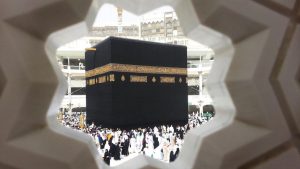 red. Not true! This has no evidence from the Sharee’ah. And any hadeeth that one may find regarding this matter is either extremely weak or fabricated. When asked about du’a being accepted at the first sight of the Ka’bah, Shaykh Sa’d al-Humayd replied:
red. Not true! This has no evidence from the Sharee’ah. And any hadeeth that one may find regarding this matter is either extremely weak or fabricated. When asked about du’a being accepted at the first sight of the Ka’bah, Shaykh Sa’d al-Humayd replied:
This is not true; there has to be evidence for this to be true, because acts of worship should only be based on evidence. And that evidence must be saheeh in and of itself and it should be clear and unambiguous. And Allah knows best.
Mistake #2. “Kissing” the black stone from far away and stopping in mid-tawaaf to do so:
Kissing the black stone is a beautiful Sunnah, and an honor indeed for the one who is able to do so. However, due to the immense crowds, a very large number of people are not able to reach it. So a large number of people try to “kiss” it from far away. When they are line with the black stone, they stop dead in their tracks in mid-tawaaf, stand facing the black stone, put up both hands on the side of their head and “kiss” the black stone in mid air, as if the black 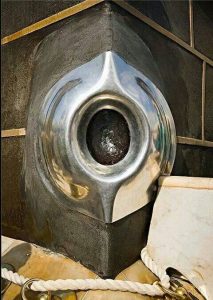 stone is right in front of them. Or they throw “flying kisses” at the black stone from far away, by kissing their hands and then “throwing” these kisses in the direction of the black stone. Besides being wrong, stopping the flow of tawaf causes disruption and unnecessary crowding in that area, and a LOT of inconvenience to fellow Haajis.
stone is right in front of them. Or they throw “flying kisses” at the black stone from far away, by kissing their hands and then “throwing” these kisses in the direction of the black stone. Besides being wrong, stopping the flow of tawaf causes disruption and unnecessary crowding in that area, and a LOT of inconvenience to fellow Haajis.
“Distance kissing” is not from the Sunnah of course. All the Prophet (Sal Allaahu Alaiyhi wa sallam) did while doing tawaaf, was to kiss the black stone if he easily could do so, or touch it with his hand and kiss his hand. BUT, when there was a crowd, all he did was point to it from far away and say “Allaahu Akbar”. That’s it.
It was narrated that Abu Tufayl (may Allah be pleased with him) said: I saw the Messenger of Allah (peace and blessings of Allah be upon him) performing Tawaaf around the House, touching the corner [where the Stone is] with a crooked staff which he had with him, then kissing the staff.
[Muslim, 1275]
It was narrated that Ibn ‘Abbaas said: The Messenger of Allah (peace and blessings of Allah be upon him) performed Tawaaf on his camel, and every time he came to the corner [where the Stone is] he would point to it and say “Allaahu akbar.”
[al-Bukhari, 4987]
And that’s what we need to do. If you are far away from the black stone, all you do is to point to it with your right hand, say Allah Akbar and move on. No facing the Ka’bah, no “distance kissing”, no stopping dead in your tracks. Keep moving and don’t disrupt the flow of the tawaaf.
Mistake #3. Shouting out duas in unison
Some people shout at the top of their voices, in unison, while making du’a during tawaaf. They follow an imam or a leader who says out different duas aloud, and then the followers all repeat after him in unison. This causes a lot of confusion and disturbs others engaged in their own duas, making them lose focus and khushoo‘. And obviously, it is also not befitting that one should shout and raise his voice in a place so sacred as the Harram.
The right thing to do is to know, before you go for tawaaf, the duas that you will be making, the Qur’aan you will be reciting, etc. so that you don’t have to follow anybody. Rather you will be making your own du’a, in your own language, from your own heart. This will give you better concentration and satisfaction. Plan your duas ahead of time, repeat them to yourself, with humility and khushoo‘. After all, you’re making du’a to the One Who hears all and sees all. The Prophet (Sal Allaahu Alaiyhi wa sallam) said:
Each one of you is conversing with his Lord, so do not disturb one another or raise your voices over one another when reading [or he said] when praying.
[Abu Dawood, saheeh by al-Albaani]
Mistake #4. Designating specific duas for specific rounds:
There are some people who make specific duas for each round and there are even books that have specific duas written for each specific round, with du’a #1 to be read for round #1 and so on. This is not something from the Sharee’ah. The Prophet (Sal Allaahu Alaiyhi wa sallam) did not recite any specific du’a in any of the rounds, and neither did his companions. If there was such a thing, then he would have told us about it, and he would have done so himself first.
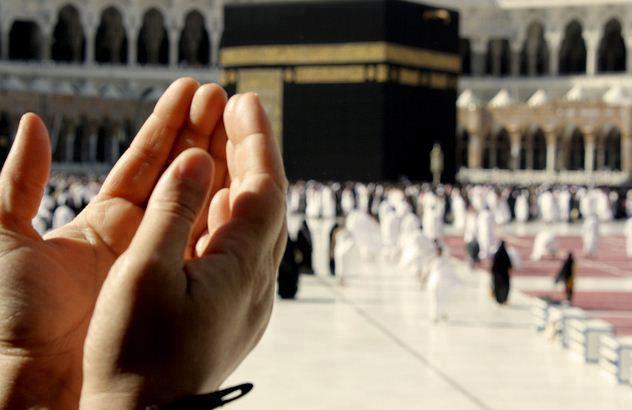
The only du’a that he did specify during Tawaaf, was when he reached at the end of each circuit between the Yemeni Corner and the Black Stone, and he would say: “Rabbana atina’ fid-dunya hasanatan wa fil-akhirati hasana wa qina adhaban-nar. ” (Our Lord, give us good in this world and good in the Hereafter and save us from the punishment of the Fire.)
So the right thing to do in each round is to make sincere du’a from your heart about whatever it is that you make du’a to Allah for, in whatever language you like, in whatever words that you feel comfortable in, until you come to the Yamani (third) corner where you can say the above du’a prescribed in the Sunnah.
Think about it. If you’re reading something from a book, in a language that you don’t understand, would that have the same effect on you or the same impact on your du’a as compared to something that you do understand? Imagine the power of the du’a that comes from deep within your heart and its effect. You are the one who knows your problems…you are the one who is afflicted…you are the one beseeching your Lord and He’s the One who knows what you’re asking for.
And even if you did understand the duas, it would still be something not prescribed in the Sunnah.
Mistake #5. Doing Tawaaf on someone else’s behalf:
Many people make this mistake. They circumambulate the Ka’bah 7 times and then they donate the reward of this tawaaf to their loved ones, their family members or their relatives who have passed away. Also, when people go for Hajj or Umrah, their relatives and friends specifically ask them to “do one tawaaf on their behalf”. This is not valid and there is no evidence for its permissibility.
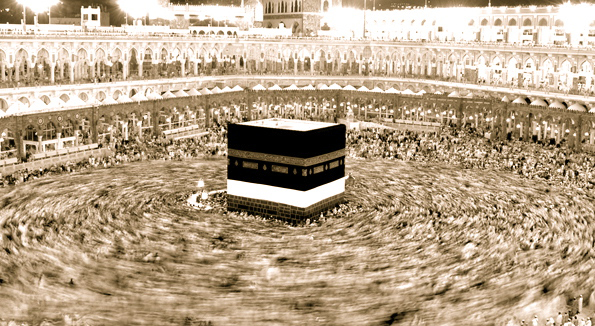
You see, Tawaaf is a kind of prayer and you cannot pray on someone else’s behalf. Can you? Similarly, you cannot do just tawaaf by itself on someone else’s behalf either. However, if you were doing an entire Hajj or Umrah on someone’s behalf, then the tawaf would be automatically be on the other person’s behalf anyway. But to do tawaaf by itself, meaning 7 rounds around the Ka’bah and donating the reward to someone else is not correct. Shaykh ibn Baaz said:
Tawaaf around the Ka’bah cannot be done by proxy, so no one can do tawaaf on behalf of someone else, unless he is doing Hajj or ‘Umrah on his behalf, in which case he may do it on his behalf along with the rest of Hajj or ‘Umrah.
[Fataawa Ibn Baaz]
What the best thing to do is to do as many tawaaf as you can for your own self. Tawaaf is an Ibaadah that cannot be done anywhere else except Makkah and this is a golden opportunity.
Mistake #6. Hair Cut after Saee:
People start cutting their hair in as soon as they complete their Umrah at the end of Saee on Marwa mountain. They cut their hair from 2,3 places and consider that they are done with Umrah.
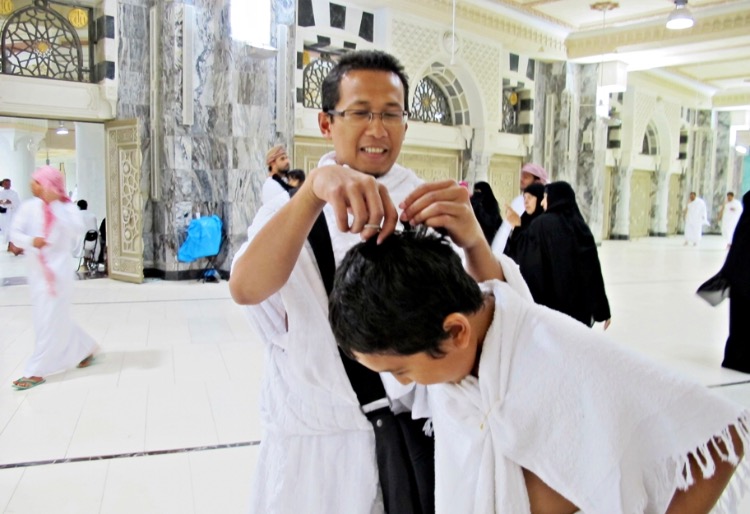
The correct way of doing this is to go to proper barber and ask him to cut your hair from all over the head. Cutting your hair from 2,3 places on the head does not relieve you from the conditions of the Ahram.
There are some people who, when they have finished saa’i, if they cannot find anyone to shave their heads or cut their hair, they go back to their houses and exit ihraam, and put on regular clothes, then they shave their heads or cut their hair after that. This is a serious mistake, because a person cannot exit ihraam without shaving his head or cutting his hair, as the Prophet (peace and blessings of Allaah be upon him) said, when during the Farewell Pilgrimage he commanded those of his companions who had not brought a hadiy (sacrificial animal) to make it ‘Umrah, and he said,
Let him cut his hair then exit ihraam.
[Bukhaari, 1691; Muslim, 1229]
This indicates that one cannot exit ihraam until after cutting the hair.
Mistake #7. Thinking that the Jamaraat are Shayaateen:
When some people go to stone the Jamaraat, they think they are going to stone the devils. In fact, they think they are stoning Iblees himself! They even call this ritual, “stoning the SHAYTAAN.” That is NOT TRUE. The Jamaraat are NOT shayaateen and to call the Jamaraat “Shayateen” is also wrong.
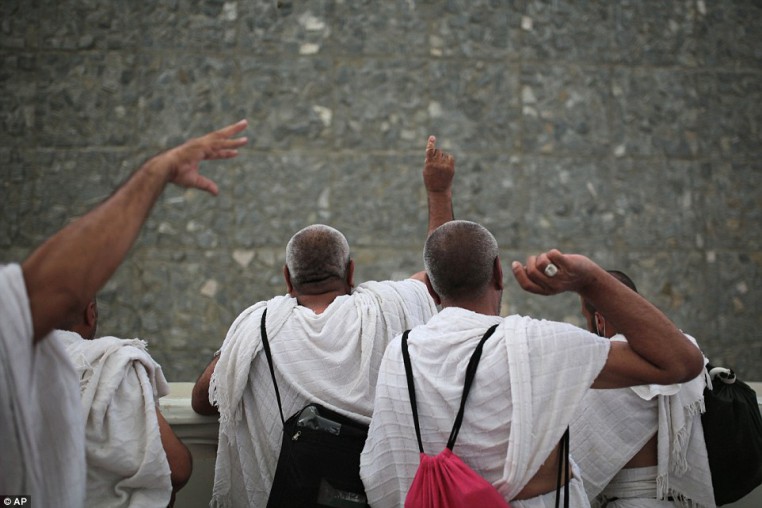 All we do when we stone these Jamaraat is an act of remembering Allah, following the Messenger of Allah(Sal Allaahu Alaiyhi wa sallam) as an act of worship. That’s it. No need to get emotional, no need to cuss at the Jamaraat, no need to push and shove.
All we do when we stone these Jamaraat is an act of remembering Allah, following the Messenger of Allah(Sal Allaahu Alaiyhi wa sallam) as an act of worship. That’s it. No need to get emotional, no need to cuss at the Jamaraat, no need to push and shove.
Mistake #8. Touching or wiping over the Ka’bah, any part of masjid al-Haraam or Masji an-Nabawi:
Some people try and touch any part of the Ka’bah or Maqaame Ibraaheem, thinking that there is blessing or barakah in it. Or they touch or wipe their hands on the different parts of masjid al-Haraam or masjid an-Nabawi, and then they wipe over themselves, thinking that this is something good or it will be source of blessing for them.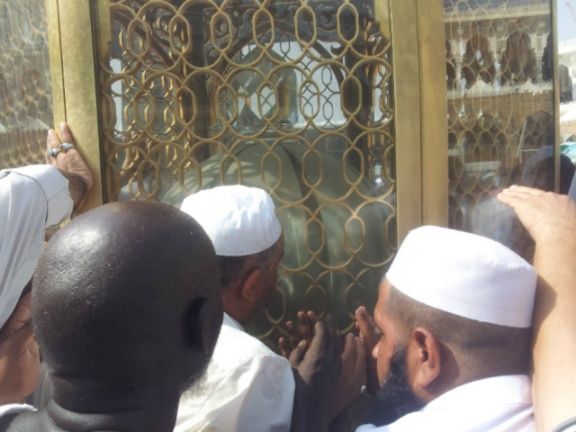 But again, this is another act with no basis in the Sharee’ah of Islam. The Prophet (Sal Allaahu Alaiyhi wa sallam) did not touch any part of Ka’bah except the Black Stone and the Yemeni Corner. If it was good, he would have done so. But he didn’t and so we don’t either.
But again, this is another act with no basis in the Sharee’ah of Islam. The Prophet (Sal Allaahu Alaiyhi wa sallam) did not touch any part of Ka’bah except the Black Stone and the Yemeni Corner. If it was good, he would have done so. But he didn’t and so we don’t either.
Dear brother/sister, just think about it. Blessings come from following what Allah and His Messenger (Sal Allaahu Alaiyhi wa sallam) have prescribed, and NOT from following innovations.
Mistake #9. Thinking that praying forty prayers in Madeenah is compulsory:
Some people think that you have to complete forty prayers in the Prophet’s masjid and that this is necessary and part of Hajj. It’s not. This is based on a weak hadeeth. Neither is it necessary to complete forty prayers there nor is visiting Madeenah a part of Hajj. 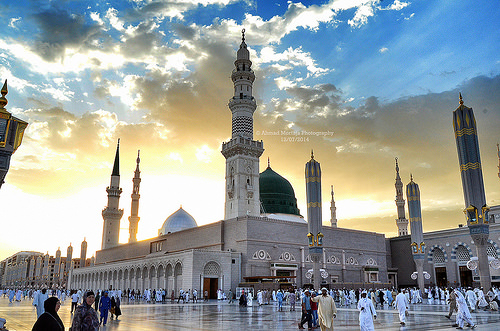 Obviously it is good if you can spend as much time as you can in Madeenah and pray as much as you can in masjid an-Nabawi. But to think that one has to complete forty prayers there is not correct. You can pray one day or one hour or one month or whatever is according to your hajj program. It does not have to be forty prayers. Shaykh Ibn Baaz said:
Obviously it is good if you can spend as much time as you can in Madeenah and pray as much as you can in masjid an-Nabawi. But to think that one has to complete forty prayers there is not correct. You can pray one day or one hour or one month or whatever is according to your hajj program. It does not have to be forty prayers. Shaykh Ibn Baaz said:
With regard to the widespread idea that the visitor should stay for eight days so that he can offer forty prayers in the Mosque is wrong. Although it says in some ahaadeeth “Whoever offers forty prayers therein Allah will decree that he is safe from the Fire and free from hypocrisy,” this hadeeth is da’eef according to the scholars and cannot be taken as proof or relied upon. There is no set limit for visiting the Prophet’s Mosque. If a person visits for an hour or two, or a day or two, or for more than that, there is nothing wrong with that.
[Fataawa Ibn Baaz]
Mistake #10. Wearing Ihraam below wasit-line:
Men wearing Ihraam below their waist lines is a serious mistake. Since, as a result, the area below the belly button is exposed to every one. This is the private area and every Muslim has the responsibility to hide it from others. It is not appropriate to pray even Salah if this area is exposed.
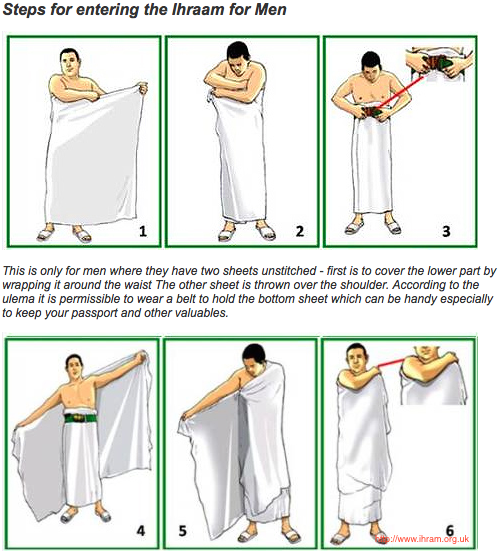
These are just ten mistakes, sadly there are others too. Brothers and sisters, check with reliable sources what to do and what not to do during Umrah and Hajj. You wouldn’t want your worship to go to waste since you didn’t pay attention to the details.
May Allah help us in our acts of worship to be from the Qur’ān and the Sunnah.
Source: Muslim Matters, Saudi Gazette and Islam QA



